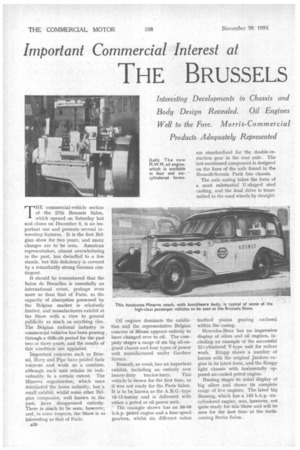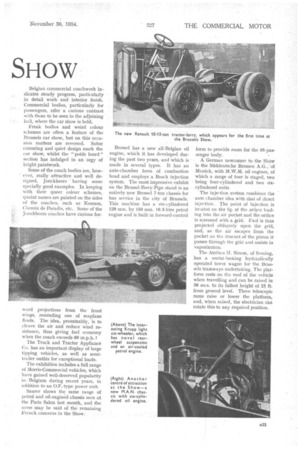Important Commercial Interest at
Page 48

Page 49

If you've noticed an error in this article please click here to report it so we can fix it.
THE BRUSSELS SHOW
THE commercial-vehicle section of • the 27th Brussels Salon, which opened on Saturday last and closes on December 5, is an important one and presents several interesting features. It is the first Belgian show for two years, and many changes are to be seen. American representation, almost overwhelming in the past, has dwindled to a few stands, but this deficiency is covered by a remarkably strong German contingent.
It should be remembered that the Salon de Bruxelles is essentially an international event, perhaps even more so than that of Paris, as the capacity of absorption possessed by the Belgian market is relatively limited, and maaufacturers exhibit at the Show with a view to general publicity as much as anything else. The Belgian national industry in commercial vehicles has been passing tlirough. a difficult period for the past two or three years, and the results of this condition are apparent.'
Important concerns such as Brossel, Rovv and Pipe have Pobled their interests and work as a combine, although each unit retains its individuality to a certain extent. The Minerva organization, Which once dominated the home industry, has a small exhibit, whilst some other Belgian companies, well known in the past,: have disappeared entirely. There is much to be seen, however; and, in some respects, the Show is as interesting as that of Paris.
B30
• Oil engines dominate the exhibition and the representative Belgian ; concern of Miesse appears entirely to have clanged over to oil. The company-stages a range of six big oil-engined chassis and four types of power unit manufactured under Gardner licence,
Renault. as usual, has an important exhibit, including an entirely new 'heavy-duty tractor-lorry. This vehicle is shown for the first time, as it was not ready for the Paris Salon.
. It is to be known as the A.B.G.-type 1I)-12-tonner and is delivered with either a petrol or oil power unit, The example shown has an 80-90 b.h.p. petrol engine and a four-speed gearbox, whilst six different ratios are standardized for the double-reduction gear in the rear axle. The last-mentioned component is designed on the lines of the axle found in the Renault-Scemia Paris bus chassis.
The axle casing takes the form of a most substantial U-shaped steel casting, and the final drive is transmitted to the road wheels by straight
toothed pillion gearing enclosed within the casing.
Mercedes-Benz has an impressive display of oilers and oil engines, including an example of the successful 12-cylindered V-type unit for railcar work. Krupp shows a number of lorries with the original Junkers engine in its latest form, and the Krupp light chassis with horizontally opposed air-cooled petrol engine.
Bussing stages its usual display of big oilers and shows its complete range of five engines. The latest big Bussing, which has a 145 b.h.p. sixcylindered engine, was, however, not quite ready for this Show and will be seen for the first time at the forthcoming Berlin Salon. Belgian commercial coachwork indicates steady progress, particularly in detail work and interior finish. Commercial bodies, particularly for passengers, offer a curious contrast with those to be seen in the adjoining hall, where the car show is held.
Freak bodies and weird colour schemes are often a feature of the Brussels car show, but on this occasion matters are reversed. Sober colouring and quiet design mark the car show, whilst the " poids lourd " section has indulged in an orgy of bright paintwork.
Some of the coach bodies are, however, really attractive and well designed, jonckheere having some specially good examples. In keeping with their queer colour schemes, quaint names are painted on the sides of the coaches, such as Kosmos, Chemin de Paradis, etc. Some of the jonckheere coaches have curious for ward projections from the front wings, reminding one of seaplane floats. The idea, presumably, is to cleave the air and reduce wind resistance, thus giving fuel economy when the coach exceeds 80 m.p.h.!
The Truck and Tractor Appliance Co. has an important display of large tipping vehicles, as well as semitrailer outfits for exceptional loads.
The exhibition includes a full range of Morris-Commercial vehicles, which have gained well-deserved popularity in . Belgium during recent years, in addition to an 0.F.-type power unit.
Saurer shows the same range of petrol and oil-engined chassis seen at the Paris Salon last month, and the same may be said of the remaining French concerns in the Show.
Brossel has a new all-Belgian oil engine, which it has developed during the past two yeses, and which is made in several types. It has an ante-chamber form of combustion head and employs a Bosch injection system. The most impressive exhibit on the Brossel-Bovy-Pipe stand is an entirely new Brossel 7-ton chassis for bus service in the city of Brussels. This machine has a six-cylindered 120 mm. by 150 mm. 10.3-litre petrol engine and is built in forward-control form to provide room for the 65-passenger body.
A German newcomer to the Show is the Stiddeutsche Bremen A.G., of Munich, with M.W.M. oil engines, of which a range of four is staged; two being four-cylindered and two sixeylindered units,
The injection system combines the ante chamber idea with that of direct injection. The point of injection is located on the lip of the orifice leading into the air pocket and the orifice is screened with a grid. Fuel is thus projected obliquely upon the grid, and, as the air escapes from the pocket on the descent of the piston it passes through the grid and assists hi vaporization.
The Ateliers IL Simon, of Seraing, has a useful-looking hydraulically operated tower wagon for the Brussels tramways undertaking. The platform rests on the roof of the vehicle when travelling and can be raised in 30 secs. to its fullest height of 25 ft. from ground level. Three telescopic rams raise or lower the platform, and, when raised, the electrician can rotate this to any required position.




































































































